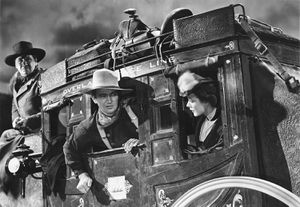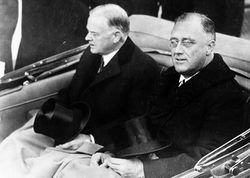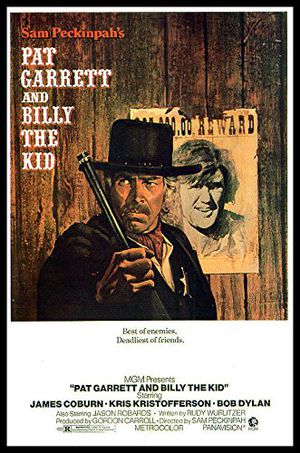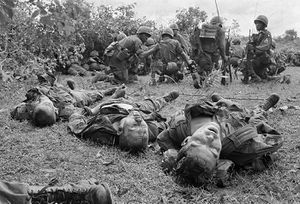Difference between revisions of "How Did the Great Depression and the Vietnam War Help Shape the Hollywood Western?"
Costello65 (talk | contribs) (Created page with "{{Mediawiki:Banner1}} thumbnail|300px|''Laugh Kills Lonesome,'' Charles M.Russell, 1925. Western films are often mistaken as simple reels of fu...") |
Costello65 (talk | contribs) (created page) |
||
| Line 3: | Line 3: | ||
Western films are often mistaken as simple reels of fun, romance, and excitement. Although they can be amusing to watch, these films are produced through the combination of myths, facts, and societal influence. ''Stagecoach,'' released in 1939 and ''Pat Garrett and Billy the Kid,'' from 1973 imply that moral and legal justice can be in conflict, thus posing the question; is the "good guy" really good? Through analysis of these two films, it can be argued that Hollywood’s depiction of heroes and villains in this genre coincides with the socially relevant events of the period. | Western films are often mistaken as simple reels of fun, romance, and excitement. Although they can be amusing to watch, these films are produced through the combination of myths, facts, and societal influence. ''Stagecoach,'' released in 1939 and ''Pat Garrett and Billy the Kid,'' from 1973 imply that moral and legal justice can be in conflict, thus posing the question; is the "good guy" really good? Through analysis of these two films, it can be argued that Hollywood’s depiction of heroes and villains in this genre coincides with the socially relevant events of the period. | ||
| − | Frederic Remington and Charles Russell were artists who painted the American West as a romantic and adventurous frontier. They helped create the western myth by portraying their characters on canvas as rugged heroes who conquered the terrain and so-called savages of the region. The mythological West was further propagated when Fred Harvey and the slowly developing film industry created a West where one could “see the past while in the present.” | + | Frederic Remington and Charles Russell were artists who painted the American West as a romantic and adventurous frontier. They helped create the western myth by portraying their characters on canvas as rugged heroes who conquered the terrain and so-called savages of the region. The mythological West was further propagated when Fred Harvey and the slowly developing film industry created a West where one could “see the past while in the present.”<ref>Hal K. Rothman, ed., ''Devil’s Bargains'' (Lawrence: University of Kansas Press), 42.</ref>This was appealing to American audiences as the West was the arena where democratic American values were portrayed.<ref>Peter C. Rollins and John E. O’Connor, eds., ''Hollywood’s West: The American Frontier in Film, Television, and History'' (Lexington: University of Kentucky Press), 6. Historian Frederic Jackson Turner labeled the West as a "safety valve" to where Eastern populations would escape when the pressures of their region became too high.</ref>Tourism began to flourish and Americans became enamored with the romanticism of the West. The Hollywood film industry soon capitalized on the need for escapism by bringing the West to the people. Utilizing the formula of the Bronco Billy silent films ——— a good man, a girl in distress, and a gun ——— Hollywood expanded the genre into the era of talking films. Gary Cooper did well as a cowboy hero in such films as 1921’s ''The Virginian'', but the genre did not explode into success until John Wayne was made a star in the 1939 classic, ''Stagecoach''.<ref>Dudley Nichols, ''Stagecoach,'' DVD, 1939, directed by John Ford (Criterion Collection, 2010).</ref> |
== ''Stagecoach'' and the Law == | == ''Stagecoach'' and the Law == | ||
| Line 28: | Line 28: | ||
== Parallels with Vietnam == | == Parallels with Vietnam == | ||
| − | [[File:namdead1968.jpg|thumbnail|300px|Associated Press photograph from September 18, | + | [[File:namdead1968.jpg|thumbnail|300px|Associated Press photograph from September 18, 1965 during the battle of An Ninh.]] |
| + | At the time the film was released, the American public had been inundated with images of the horrific violence in Vietnam. Peckinpah used an abundance of violence in the film and displays blood in stark red ''only'' when the outlaws are shot. He was demonstrating that the established authority figures were responsible for the blood and violence in the film, just as they were in Southeast Asia. He also made an obvious point of dressing Garrett and his posse in all black throughout the film, which was a wardrobe choice traditionally associated with villains. Just by employing this simple wardrobe tactic, Peckinpah depicts law enforcement as evil. He furthered this portrayal with a scene of young children throwing rocks at Garrett after he had killed the Kid; much like the rocks that were thrown at Vietnam veterans returning home. | ||
| + | |||
| + | The one redeeming quality he did give Garrett was near the beginning of the film when he warned Billy he was going to be arrested or killed and gave him the opportunity to leave the country and flee to Mexico. This was parallel to young draftees in 1973 making the difficult decision to run to Canada rather than go to Vietnam. The film version of Billy the Kid opted to stand his ground instead of fleeing to safety. Of course, the Kid was violently killed as were so many young men, who were the same age as the Kid, in Vietnam. | ||
| + | |||
| + | == Conclusion == | ||
| + | While the 1970’s were defined by Watergate and Vietnam, the 1930’s were defined by the Great Depression. Both periods were a time of unrest and discontentment with the sitting government. The fine line between good and evil was often blurred. Both films established that "good" and "bad" can only be defined through social interaction and that which has been internalized by the viewer as an acceptable norm or value. The Western is the perfect genre in which to present questions of morality as the West has been romanticized into being a land of rugged individuality where one’s choices have not yet been made. As dude ranching “acted out the myth” of the West in the 1930’s via tourism, this film genre continues to do the same with a much larger audience. It is therefore reasonable to conclude that the West is not only a place and a process but also a time; an entity not only separated by the 98th parallel, but the enactment of myth relevant to one’s present social condition. | ||
| + | |||
| + | ==References== | ||
| + | <references/> | ||
| + | |||
| + | [[Category:Wikis]] [[Category:Film History]] [[Category:U.S. History]] | ||
| + | |||
| + | {{Contributors}} | ||
Revision as of 20:51, 17 July 2016
Western films are often mistaken as simple reels of fun, romance, and excitement. Although they can be amusing to watch, these films are produced through the combination of myths, facts, and societal influence. Stagecoach, released in 1939 and Pat Garrett and Billy the Kid, from 1973 imply that moral and legal justice can be in conflict, thus posing the question; is the "good guy" really good? Through analysis of these two films, it can be argued that Hollywood’s depiction of heroes and villains in this genre coincides with the socially relevant events of the period.
Frederic Remington and Charles Russell were artists who painted the American West as a romantic and adventurous frontier. They helped create the western myth by portraying their characters on canvas as rugged heroes who conquered the terrain and so-called savages of the region. The mythological West was further propagated when Fred Harvey and the slowly developing film industry created a West where one could “see the past while in the present.”[1]This was appealing to American audiences as the West was the arena where democratic American values were portrayed.[2]Tourism began to flourish and Americans became enamored with the romanticism of the West. The Hollywood film industry soon capitalized on the need for escapism by bringing the West to the people. Utilizing the formula of the Bronco Billy silent films ——— a good man, a girl in distress, and a gun ——— Hollywood expanded the genre into the era of talking films. Gary Cooper did well as a cowboy hero in such films as 1921’s The Virginian, but the genre did not explode into success until John Wayne was made a star in the 1939 classic, Stagecoach.[3]
Contents
Stagecoach and the Law
Director John Ford stumbled upon the short story, “Stage to Lordsburg” in 1935. Four years later, Ford and screen writer Dudley Nichols turned out a socially relevant film to a weary nation. Having endured almost a decade of the Great Depression, Americans were ready for a hero that worked outside of the law. Outlaws such as John Dillinger and Charles “Pretty Boy” Floyd had captured the nation’s attention, if not affection, in the early 1930’s and "gangsters" on screen, such as Edward G. Robinson and James Cagney had won the hearts and dollars of American film-goers. The anti-hero was emerging as a popular figure in the United States. He had the ability to live outside of the law as long as he exhibited a desire to stand with the common man.
John Wayne’s portrayal of the Ringo Kid in Stagecoach was that of a man determined to exact revenge on those who murdered his family. He was pursuing justice for a crime ignored by the law. At the time of the film’s release, law officers in the U.S., especially the West, were spending a considerable amount of time evicting people from their homes and farms after bank foreclosures. Bankers and police officers were often times seen as corrupt enemies of the common man and Ford exploited this belief through his psychological study of his closely intertwined characters. He paired his characters so as to create tension through class differences and political opposition, which a prevailing theme in 1930’s America. Through his cinematic expertise, the director attacked the established order and class values by portraying the upper class and capitalist elite as morally vapid beings.
An excellent depiction of the struggle between the classes is presented in the movie via the characters of an army officer's wife and a local prostitute. Mrs. Mallory, the officer's wife, is a proper upper class woman who has no desire to see beyond how a person has been socially framed. The schema she conceived of Dallas, the prostitute, as being soiled and incapable of normalcy was proven wrong as Dallas continued to be compassionate while she endured Mrs. Mallory’s insults. Dallas prevailed as the heroine of the film while the audience showed no love for the elitist woman. While this transpired on screen, Ford was well aware that it was an ongoing struggle in the society of the time. Capitalists were trying to maintain the economic and political power they enjoyed at the end of the previous decade by any means possible, which was depicted in Stagecoach by the character of the banker.
Hoover and F.D.R.
Ford used the character of the banker to create the film’s most relevant social theme; unencumbered capitalism versus federal intervention. Early in the film the banker makes his opinions known when he states, “What’s good for the banks is good for the country.” American banks had been suspect in the public’s eye since the stock market crash of 1929 when hundreds of bankers absconded with millions of hard earned dollars. From Ford’s perspective, the banker continues his irony by opining that “what this country needs is a businessman for president.
Herbert Hoover was in office at the onset of the Depression and saw no reason for federal intervention. In his radio address of February 12, 1931, he averred that if the government were to “shoulder individual and community responsibility” that a super state would be created “where every man becomes the servant of the state and real liberty is lost.”[4]Hoover had been a businessman and was, in fact, a millionaire prior to ascending to the Presidency. The banker, who was riding the stagecoach because he was embezzling money, was a blustery portrayal of Hoover during a time when President Roosevelt was making sweeping social changes through his New Deal programs. In his message to congress on January 17, 1935 he outlined his ideas for legislation pertaining to the Social Security Act and closed his address by stating, “We cannot afford to neglect the plain duty before us.”[5]
Clearly Hoover and FDR were on opposite ends of the debate regarding governmental intervention, as was the case with many Americans at the time. Ford makes his opinions known through his scenes of the doctor punching the banker and the crowd in the street cheering and laughing when the banker was arrested at the end of the film. Unlike the characters in The Virginian, where Gary Cooper is handsome in his white hat and defends the town against the external threat of the "bad-guy" in a black hat, the characters in Stagecoach must be defined by the schemas the audience has as to what is "good" or "bad" in a given social context. The Virginian visually defines for the audience what is good or bad and right or wrong, whereas Stagecoach allows the viewer to adopt his own sense of hero and villain. John Wayne’s character, the Ringo Kid, can be seen as either, depending on the perception of the audience. He is a lone man who has mastered the terrain and frontier and has developed as a person by doing so; which echoes Turner’s “Frontier Thesis.”[6]He is also seeking moral justice through criminal action. He is in conflict with the ambiguous sheriff who personifies the law officer trying to uphold his duties while doing what is morally responsible. That was a chronic problem in depression era America as police officers had to serve eviction notices to their friends and neighbors while questioning their consciences. In the film, Sheriff Curly was trying to maintain a balance of duty and compassion. In the end Curly enabled Ringo’s moral justice, thus enabling the viewer to determine whether law and order or individual action was the best course of action to right a wrong. The sheriff portrayed in 1939 differed from the villainous presentation of Sheriff Pat Garrett in Sam Peckinpah’s 1973 adaptation of the Billy the Kid legend.
Pat Garrett and Billy the Kid
Pat Garrett and Billy the Kid was released in 1973 to a nation yet again weary. America’s participation in Vietnam’s civil war came as a result of the fear of communism spreading. The result of America’s ongoing intervention in a seemingly winless war divided the U.S. home front and turned the 1960’s and 1970’s into two extremely tumultuous decades. President Nixon had continued to "secretly" bomb Cambodia in 1973, while the Watergate investigation was exposing a corrupt Executive Branch. Outspoken advocates for peace were holding rallies and embracing the pacifist traditions of the hippies of the previous decade. May 4, 1970 proved to be a turning point in campus unrest and the college generation’s distrust of the government and law enforcement. On that day at Kent State University, four students were killed while nine others were injured at the hands of the Ohio National Guard. This event triggered a student strike through May and June of that year and even furthered the growing campus unrest.[7]
Peckinpah uses this film as a vehicle to convey his sympathies to a young, boisterous, and skeptical generation. He makes this evident immediately with his casting of the young, handsome, long-haired Kris Kristofferson as the Kid and the older and stoic James Coburn as Pat Garrett. He furthers his reach to the campus culture by casting Bob Dylan, a counter-culture hero of the 1960’s, and also by using his original music throughout the film.[8]Billy the Kid was presented as a hero facing off against his former friend Pat Garrett, who was appointed sheriff by the cattle barons in control of the region. In New Mexico Territory in 1881, the appointment of a law officer by the monied few was fact and not myth. Masses of people had streamed west faster than law enforcement could be put into place, therefore capitalists created their own versions of law and order. This also spoke to the anti-establishment youth who believed money and power were corrupt. Peckinpah also defined heroes and villains for the audience with visual artistry.
Parallels with Vietnam
At the time the film was released, the American public had been inundated with images of the horrific violence in Vietnam. Peckinpah used an abundance of violence in the film and displays blood in stark red only when the outlaws are shot. He was demonstrating that the established authority figures were responsible for the blood and violence in the film, just as they were in Southeast Asia. He also made an obvious point of dressing Garrett and his posse in all black throughout the film, which was a wardrobe choice traditionally associated with villains. Just by employing this simple wardrobe tactic, Peckinpah depicts law enforcement as evil. He furthered this portrayal with a scene of young children throwing rocks at Garrett after he had killed the Kid; much like the rocks that were thrown at Vietnam veterans returning home.
The one redeeming quality he did give Garrett was near the beginning of the film when he warned Billy he was going to be arrested or killed and gave him the opportunity to leave the country and flee to Mexico. This was parallel to young draftees in 1973 making the difficult decision to run to Canada rather than go to Vietnam. The film version of Billy the Kid opted to stand his ground instead of fleeing to safety. Of course, the Kid was violently killed as were so many young men, who were the same age as the Kid, in Vietnam.
Conclusion
While the 1970’s were defined by Watergate and Vietnam, the 1930’s were defined by the Great Depression. Both periods were a time of unrest and discontentment with the sitting government. The fine line between good and evil was often blurred. Both films established that "good" and "bad" can only be defined through social interaction and that which has been internalized by the viewer as an acceptable norm or value. The Western is the perfect genre in which to present questions of morality as the West has been romanticized into being a land of rugged individuality where one’s choices have not yet been made. As dude ranching “acted out the myth” of the West in the 1930’s via tourism, this film genre continues to do the same with a much larger audience. It is therefore reasonable to conclude that the West is not only a place and a process but also a time; an entity not only separated by the 98th parallel, but the enactment of myth relevant to one’s present social condition.
References
- ↑ Hal K. Rothman, ed., Devil’s Bargains (Lawrence: University of Kansas Press), 42.
- ↑ Peter C. Rollins and John E. O’Connor, eds., Hollywood’s West: The American Frontier in Film, Television, and History (Lexington: University of Kentucky Press), 6. Historian Frederic Jackson Turner labeled the West as a "safety valve" to where Eastern populations would escape when the pressures of their region became too high.
- ↑ Dudley Nichols, Stagecoach, DVD, 1939, directed by John Ford (Criterion Collection, 2010).
- ↑ Colin Gordon, ed., Major Problems in American History, 1920-1945 (Boston: Wadsworth, 1999), 184.
- ↑ Gordon, 310-11.
- ↑ Frederic Jackson Turner presented his “Frontier Thesis” in 1893, which posited that the frontier was closed three years prior due to population statistics. He also argued that the frontier was an ideal and not an actual place and that it was what had defined America and Americans.
- ↑ Jerry M. Lewis and Thomas R. Hensley, “The May 4 Shootings at Kent State University: The Search for Historical Accuracy.” Kent State, 1998. http://dept.kent.edu/sociology/lewis/lewihen.htm
- ↑ Rudy Wurlitzer, Pat Garrett and Billy the Kid, DVD, 1973, directed by Sam Peckinpah (Burbank, CA: Turner and Warner Bros., 2006).
Admin, Costello65 and EricLambrecht




